
* While the large flying boat is generally a thing of the past, there are a few survivors. Among them are the Japanese ShinMaywa "PS-1" / "US-1" / "US-2", and the Chinese Harbin "SH-5". These big, elegant, four-turboprop aircraft remain in service in limited numbers. This document provides a history of the PS-1, US-1, SH-5, and its AG600 follow-on -- as well as the smaller Canadair / Bombardier CL-215 / CL-415 flying boat.

* The Japanese Kawanishi aircraft company had designed a number of flying boats into World War II, most significantly the superlative H8K, one of the best flying boats of the conflict. While Japan's defense industries were suppressed by the American occupation authorities after the country's defeat, they slowly began to re-emerge as the US turned to Japan as an East Asian ally in the Cold War against the Communist Bloc. The Kawanishi company was resurrected in 1949 as "ShinMaywa", in the relatively humble role of a service company that overhauled American, and later Japanese, military and civil aircraft.
However, the company had not forgotten its roots, and in 1959 ShinMaywa rebuilt a Grumman UF-1 Albatross flying boat provided by the US Navy to experiment with new flying boat concepts. The modified Albatross, designated the "UX-FS", performed its initial flight on 25 December 1962. The UX-FS was fitted with four engines, two of them the Albatross's normal Wright R-1820 radials with 1,065 kW (1,425 HP) each, plus two additional Pratt & Whitney R-1340 radials with 450 kW (600 HP) each. The aircraft's hull was extensively modified, and the Albatross's conventional tail was replaced by a tee tail.
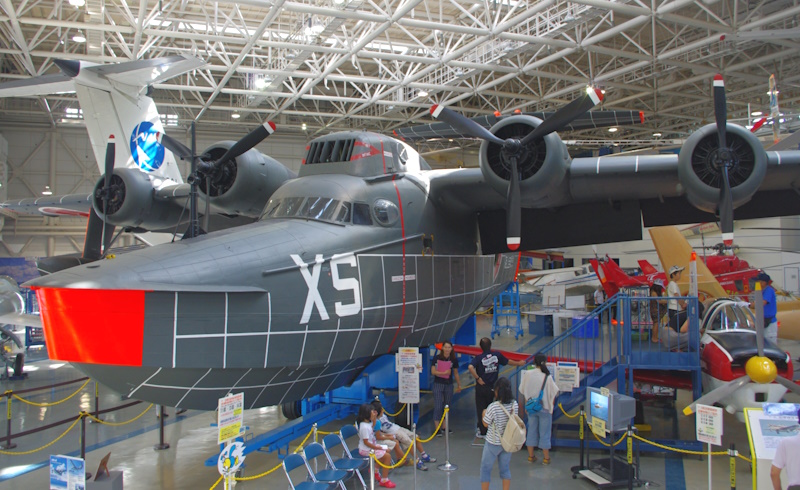
The UF-XS was also fitted with a General Electric (GE) T58 turboshaft engine providing 935 kW (1,250 SHP), mounted above and behind the cockpit. This engine simply blew air over the flaps and tail to provide a "boundary layer control (BLC)" system for improved short take-off & landing (STOL) performance. The UF-XS was flown in trials into 1964, and validated many concepts for advanced flying boat design. It remains on display in a Japanese air museum.
* In January 1966, the Japanese Defense Agency (JDA) awarded ShinMaywa a contract for further development of the company's flying boat concepts. The contract specified development of two full-scale prototypes, with the project designation "PX-S" and company designation "SS-2". The PX-S was intended primarily for antisubmarine warfare (ASW). Dr. Kikuhara Shizuo was in charge of the design team.
The first PX-S prototype took to the air from Kobe harbor on 5 October 1967, with the second following on 14 June 1968. Evaluation by the Japan Maritime Self-Defense Force (JMSDF) began late in 1968. The results of the evaluation were positive, and two preproduction "PS-1" aircraft were ordered in March 1969, with initial delivery in late 1971.
The PS-1 was powered by four General Electric T64-IHI-10 turboprop engines providing 2,280 kW (3,060 SHP) each, built under license by Ishikawajima-Harima Heavy Industries (IHI), mounted on a high-set wing. Each engine drove a three-blade reversible-pitch Hamilton Standard propeller. As with the UF-XS test aircraft, a GE T58 turboshaft engine, also built by IHI, was mounted in the upper center of the fuselage to drive a BLC system for improved STOL performance. In addition, the T58 could be used as an auxiliary power unit (APU). STOL capability was further enhanced by leading-edge slats on the outboard sections of the wings and the tailplane, as well as overwing spoilers and large flaps. Take-off speed was about 90 KPH (55 MPH).
The PS-1 featured a tall tee tail like that of the UF-XS. A fixed stabilizing float was fitted to each wingtip, and the aircraft had built-in retractable tricycle beaching gear, though it could only actually land on water. The nose gear retracted into the hull, while the main gear pivoted up into the sides of the fuselage.
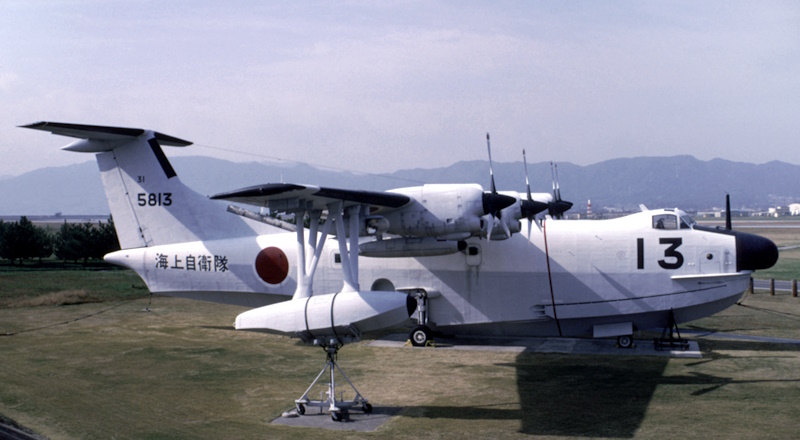
The aircraft was fitted with an interesting system in which water was pumped alongside the fuselage to suppress sea spray; spray was also deflected by strakes mounted alongside the nose of the aircraft. These measures helped to ensure that the engines wouldn't be flooded with sea water on landings and take-offs. A sea anchor was carried in the bow. The aircraft's boat hull was unusually slender, making it very stable in rough seas, and it could land and take off in swell heights of up to 4.3 meters (14 feet). Most flying boats can operate only on calm seas or protected waters, but the PS-1 was capable of landings and take-offs under severe ocean conditions. The seaworthiness of the PS-1 was far superior to that of any World War II flying boat.
Sensor systems included search radar with the antenna in a prominent nose radome; a "magnetic anomaly detection (MAD)" system with a retractable tail "stinger; a "Jezebel" passive sonar system with 20 sonobuoys; a "Julie" active sonar system using explosive charges to generate sound pulses for the sonobuoys; and a searchlight mounted under the right wing. Four 150 kilogram (330 pound) depth charges could be carried internally. Pods between the engines on each wing could carry two homing torpedoes each, for a total of four torpedoes, while a pod on each wingtip could accommodate three 127-millimeter (5-inch) rockets, for a total of six rockets. There was no defensive armament.
The PS-1 carried a crew of nine, including pilot and copilot; flight engineer; radio operator; radar operator; MAD operator; two sonar operators; and a tactical coordinator. The raised flight deck provided excellent visibility, and bunks were included for long-range patrols. The end result was a very appealing aircraft, a worthy successor to the H8K of World War II.
* The JMSDF ordered a total of 21 PS-1s, not counting the two prototypes, with the last delivered in the spring of 1978. However, as often happens with Japanese defense programs, the protracted development and small production run of the PS-1 led to very high unit costs. The program was politically controversial, all the more so because PS-1s suffered a series of accidents -- though the mishaps were not related to design or construction faults. Another difficulty was that though the idea of using a flying boat for ASW operations had its attractions, in that the aircraft could set down on the water and drop a dunking sonar to hunt for submarines, in practice land-based aircraft could do a perfectly adequate job of ASW at much lower cost. Procurement of the PS-1 was halted in 1980 in favor of the Lockheed P-3C Orion, and the PS-1 was completely out of service by 1989.
BACK_TO_TOP* Retirement of the PS-1 did not take Japan completely out of the flying boat business. Early in PS-1 production, the JMSDF asked ShinMaywa to develop an amphibian version of the PS-1 for the "search and rescue (SAR)" role to replace the service's Grumman UF-1 Albatross flying boats. The new SAR flying boat was given the military designation of "US-1" and the company designation of "SS-2A". Since the aircraft was effectively just a PS-1 with different kit, there was no US-1 prototype. Initial flight of the first US-1 was on 15 October 1974, with introduction to service in 1975.
The US-1 was much like the PS-1, but lacked armament and all sensor systems except ocean search radar. It had additional fuel capacity and was fitted with true landing gear to allow it to take off and land on airstrips. The main gear was configurationally like that of the PS-1, but much scaled up, featuring two wheels on each gear assembly, and retracted into prominent fairings on the fuselage under the wings. The hefty main landing gear of the US-1 provided a useful recognition feature against the spindly main gear of the PS-1, the two variants otherwise being hard to tell apart. The landing-gear track was narrow, but the aircraft still handled well on crosswind landings.
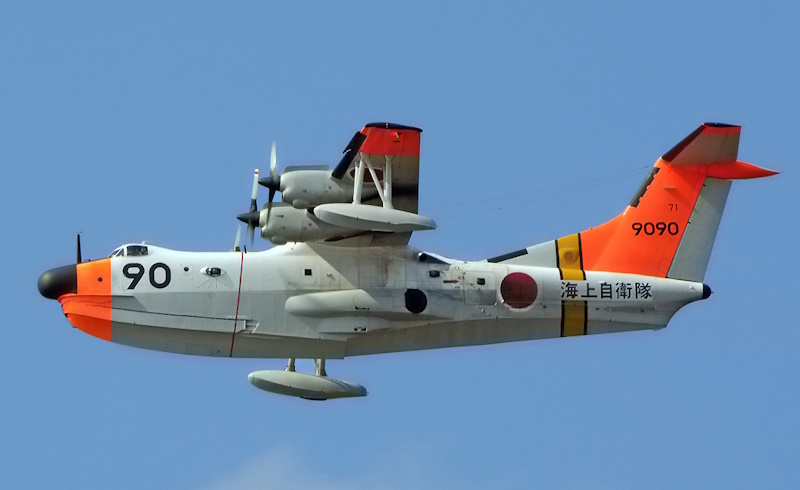
Additional "bubble" windows were provided for observers. Along with rescue hatches with folding ramps, a large sliding door was built into the right side of the aircraft to allow launch and recovery of an inflatable rescue dinghy. A hoist was fitted above the sliding door; a loudspeaker system allowed the flight crew to give instructions to survivors; and a dye-marker launcher, with a capacity of ten markers, could be used to mark patches of sea during rescue operations.
The US-1 had a crew of eight, including pilot; copilot; flight engineer; navigator; radio operator; radar operator; and two observers. Up to five medics or rescue divers could be carried as well. The aircraft could accommodate 12 stretchers and three sitting passengers, or 36 sitting passengers. In principle, the SAR gear could also be removed to allow conversion of the US-1 into a troop transport, with 100 seats.
___________________________________________________________________
SHINMAYWA US-1:
___________________________________________________________________
wingspan:
33.15 meters (108 feet 9 inches)
wing area:
135.82 sq_meters (1,462 sq_feet)
length:
33.46 meters (109 feet 9 inches)
height:
9.82 meters (32 feet 3 inches)
empty weight:
25,500 kilograms (56,220 pounds)
loaded weight:
45,000 kilograms (99,200 pounds)
max speed at altitude:
495 KPH (310 MPH / 270 KT)
service ceiling:
8,200 meters (27,000 feet)
range:
4,200 kilometers (2,610 MI / 2,270 NMI)
___________________________________________________________________
An initial batch of 12 US-1s was built. The seventh and following aircraft were fitted with uprated T64-IHI-10J turboshaft engines, providing 2,605 kW (3,490 SHP) each; these aircraft were designated "US-1A", with earlier production aircraft upgraded to the same standard. A total of 20 US-1 / US-1A machines was manufactured up to the last example, built in 2004. The US-1 has proven extremely useful and capable, and was heavily employed in maritime SAR activities after the shoot-down of Korean Air Lines flight 007 by the Soviets in 1983. Up to 1999, the US-1 / US-1A was credited with saving 550 lives.
ShinMaywa proposed a commercial transport version of the US-1 with seating for 69 passengers, but it was just too expensive and didn't happen. The first prototype of the PS-1 and a US-1 were also used in trials by the JMSDF and Japan National Fire Agency as a "water bomber" to fight forest fires.
* Despite the small production numbers of the PS-1 and US-1, production of the family continued with a new version, originally designated the "US-1A Kai", where "Kai" was short for "kaizen (modification)". The project was initiated in 1996, with the development contract specifying construction of two flight prototypes and two static-test prototypes. The first prototype performed its initial flight on 18 December 2003, taking off and landing in Osaka Bay. The first production machine went into formal JMSDF service in 2007, with the aircraft receiving the service designation of "US-2".
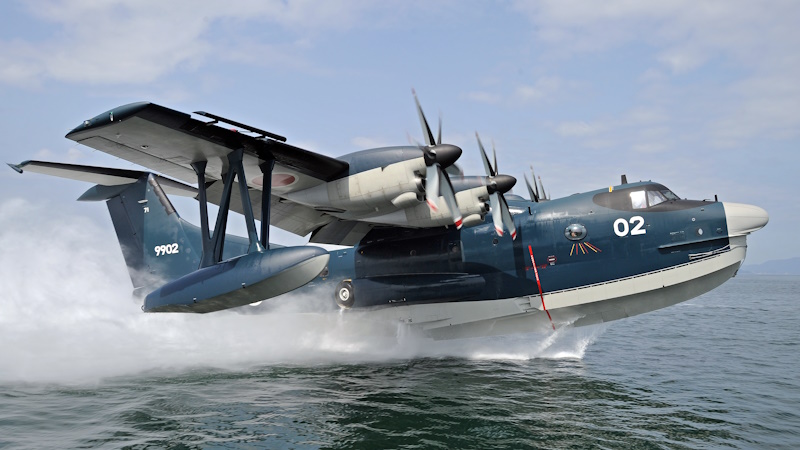
The US-2 was externally very similar to the US-1A, the most significant difference being that it was fitted with substantially more powerful Rolls-Royce AE-2100J engines, providing 3,425 kW (4,590 SHP) each, driving Dowty six-bladed propellers instead of the three-bladed propellers of the US-1A. The flap-blowing system was driven by an LHTEC CTS800-4K turboshaft, a civil version of the T800 military turboshaft, providing max power of about 1,015 kW (1,360 SHP). Performance and take-off weight were improved. It is unclear if IHI license-built the AE-2100J engines.
The US-2 also had a modified wing with integral fuel tanks and a pressurized upper cabin, permitting a ceiling of 6,100 meters (20,000 feet), twice that of the unpressurized US-1A. Avionics were updated, including a glass cockpit and French Thales Ocean Master search radar. No doubt the modernized avionics suite included a Global Positioning System navigation satellite receiver, a very handy item for an oceanic SAR machine.
The JMSDF has obtained 5 US-2s at last notice. It appears they are all new-build machines. As of 2024, ShinMaywa is conducting an improvement program for the US-2, including an automatic night-landing capability, as well as substantially increased cargo capacity.
The cargo capacity will be raised by reinforcement of floor panels and expansion of doors. ShinMaywa officials claim that the front-load capacity of the US-2 could be doubled from 2 to 4 tonnes (4,400 to 8,800 pounds), with aft capacity improved from 1 to 1.4 tonnes (2,200 to 3,085 pounds). Incidentally, the US-2 already can carry two small inflatable boats that can be used by special operations forces for a beach landing; or visit, board, search, and seizure (VBSS) maritime interdiction. The upgrade might allow additional boats to be carried.
BACK_TO_TOP* While the Japanese were developing the PS-1, the Chinese began work on a comparable aircraft. In early 1970, after several years of consideration of various preliminary designs, the Harbin Aircraft Manufacturing Corporation (HAMC) and the Chinese Seaplane Design Institute began formal work on a four-turboprop flying boat that could be used for maritime warfare, SAR, and cargo transport roles. The aircraft was to be designated the "Maritime Bomber 5 (Shuishang Hongzhaji 5 / SH-5)", though sources mention an alternate "PS-5" designation.
A static test airframe was completed in 1971, but due to the upheavals and lunacy of the Chinese "Cultural Revolution", tests did not begin until August 1974. A flying prototype had been rolled out in December 1973, with the machine beginning taxi trials in May 1975 and performing its first flight on 3 April 1976. The slow pace of the program continued, a single production batch of six aircraft being completed in 1984 and 1985, with four of them handed over to the People's Liberation Army Naval Air Force in 1986. They have been retained in service, and may have received some combat electronic system updates.
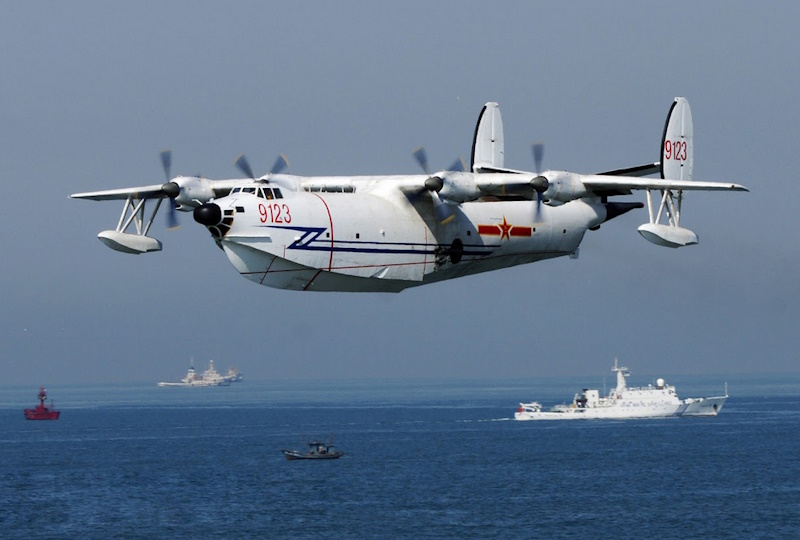
* The SH-5 had a very general resemblance to the PS-1 / US-1, with a long, relatively slender, fuselage and hull, a high wing with four turboprops, and a fixed float near each wingtip. However, when inspected in more detail it clearly more resembled the Soviet Beriev Be-12 flying boat, with a twin-fin tail and similar nose layout with glazing.
The SH-5 was powered by four Dongan WJ5A turboprop engines with 2,350 kW (3,150 SHP) each, driving four-bladed propellers. The aircraft was a pure seaplane, though it did have built-in beaching gear roughly similar to that of the PS-1. There were spray-suppression strakes on each side of the nose, and a small sea rudder at the rear of the hull.
The SH-5 was armed with a dorsal turret mounting twin cannon, and there were two stores pylons on each wing -- one placed between the hull and the inboard engine, the second placed between the inboard and outboard engines. These four stores pylons could each be fitted with an antiship missile, or each of the outer stores pylons could be fitted with three homing torpedoes. Six tonnes (13,200 pounds) of other stores, such as depth charges, mines, bombs, sonobuoys, or rescue gear could be stored in a rear compartment in the fuselage. A Doppler search radar was fitted in a thimble radome in the nose, and a fixed MAD boom was fitted to the tail. If configured as a cargolifter, the SH-5 could carry 10 tonnes (22,000 pounds) of cargo.
The SH-5 carried a flight crew of eight, including a pilot; co-pilot; navigator; flight engineer; radio operator; and three systems specialists. The number of specialists might vary depending on the mission. The fuselage was unpressurized. There were three freight compartments behind the cockpit area, followed by a cabin for the mission crew, a compartment for communications gear, and finally the stores compartment. There was a corridor connecting all three compartments, with watertight doors between compartments. There was one crew door on the left side of the aircraft and two doors on the right.
___________________________________________________________________
HARBIN (HAMC) SH-5 FLYING BOAT (ASW CONFIGURATION):
___________________________________________________________________
wingspan:
36 meters (118 feet 1 inch)
wing area:
144.0 sq_meters (1,550.05 sq_feet)
length:
38.9 meters (127 feet 8 inches)
height:
9.8 meters (32 feet 2 inches)
empty weight:
26,500 kilograms (58,400 pounds)
max loaded weight:
45,000 kilograms (99,200 pounds)
max speed at altitude:
555 KPH (345 MPH / 300 KT)
service ceiling:
10,250 meters (33,650 feet)
range:
4,750 kilometers (2,950 MI / 2,565 NMI)
___________________________________________________________________
One of the aircraft not delivered to the Navy was apparently evaluated as a "water bomber" for fighting forest fires. It seemed that the SH-5 was a dead-end type for years, but in 2009 the Chinese AVIC aviation manufacturing group -- of which Harbin Aircraft is now an element -- announced plans for a derivative, the "AG600 (previously TA-600) Kunlong" amphibian, named after a type of Chinese sea dragon. Initial flight was on 24 December 2017.
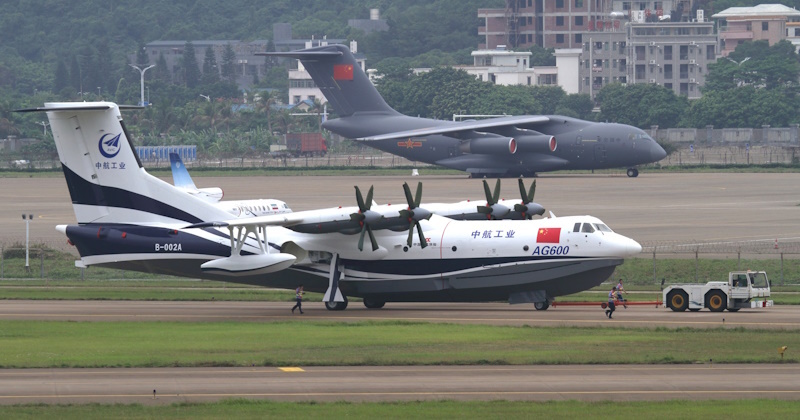
The AG600 looked much like the SH-5, but was considerably redesigned; it lacked the nose glazing and MAD boom, had a smaller nose radome, and a single tailfin in a tee tail arrangement. It had about a 10% greater MTO weight. It was intended for fire-fighting and SAR, with 17 on order from Chinese agencies. Initial deliveries were in late 2024.
BACK_TO_TOP* In the early 1960s, the Canadair company of Canada began studies for a flying boat, ultimately converging on a twin-engine amphibious aircraft, primarily intended for fire-fighting. Initial flight of the prototype "CL-215" was on 23 October 1967, with initial customer deliveries in 1969.
The CL-215 was a straightforward aircraft of deliberate simplicity, featuring all-metal construction with protection against salt water, a boxy flying boat fuselage, a straight high-mounted wing, a swept tailfin, and a straight tailplane mid-mounted on the tailfin. There was a water deflection strake wrapped around the nose. The CL-215 was powered by twin Pratt & Whitney R-2800 Double Wasp air-cooled two-row 18-cylinder radial engines, providing 1,565 kW (2,100 HP) each, driving three-bladed Hamilton Standard propellers. Fuel was carried in wing cells.
The retractable landing gear featured twin-wheel nose gear and single-wheel main gear, the main gear tucking up to the sides of the fuselage, but not actually retracting inside. There was a fixed float near each wingtip. Flight control arrangement was conventional: one-piece slotted flaps, ailerons, rudder, elevators, and trim tabs. Flight controls were manual, except for hydraulically-boosted flaps. Avionics were conventional as well: radios plus navigation and landing aids. There were dual controls and two aircrew. There were doors fore and aft of the wing on the left; an emergency exit door behind the wing on the right; an escape hatch above the cockpit; and a mooring hatch on top of the nose.
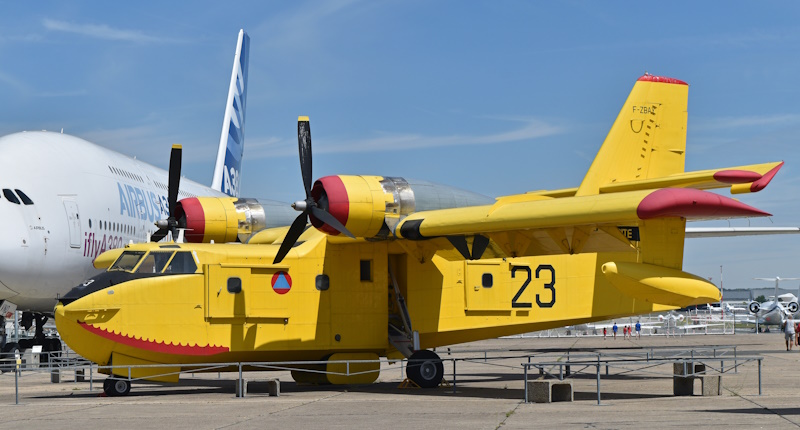
The baseline CL-215 was configured for both fire-fighting and utility duties. It featured twin tanks for water or fire retardant, with scoops on the bottom for picking up water from lakes or rivers, and drop doors for dispensing the load. A sprayer kit was offered to allow the CL-215 to spray pesticides and the like. Along with the tanks, there were folding seats for 8 passengers; removing part or all of the tank kit allowed carriage of up to 36 passengers. There was also a SAR version, with a nose thimble for AN/AVQ-21 radar, optional searchlight, IFF and better navaids, plus bulged windows. The SAR version's crew added a navigator, flight engineer, and two observers, along with provisions for four seats or six stretchers.
___________________________________________________________________
CANADAIR CL-15:
___________________________________________________________________
wingspan:
28.6 meters (93 feet 10 inches)
wing area:
100.3 sq_meters (1,080 sq_feet)
length:
19.82 meters (65 feet)
height:
8.92 meters (29 feet 3 inches)
empty weight:
12,160 kilograms (26,810 pounds)
max take-off weight (off water, land 15% greater):
17,100 kilograms (37,700 pounds)
cruise speed;
290 KPH (180 MPH / 155 KT)
service ceiling;
10,250 meters (33,650 feet)
range;
2,090 kilometers (1,300 MI / 1,130 NMI)
___________________________________________________________________
Total build of the CL-215 up to end of production in 1990 was 125 aircraft. The most prominent users were Canada, including provincial governments and some commercial users; the French Securite Civile; and Greece. Other users included Italy, Portugal, Spain, Thailand, Turkey, Venezuela, and Yugoslavia. The CL-215 became a common sight in European wildfire-fighting operations.
* In the late 1980s, Bombardier -- which had taken over Canadair -- began to investigate turboprop power for the CL-215, initially focusing on an update program for existing CL-215 flying boats. From 1987, two CL-215s were kitted up with Pratt & Whitney Canada (PWC) PW123AF turboprops with 1,775 kW (2,380 SHP) each, driving four-bladed reversible Hamilton Standard propellers, performing test flights from 1989. The "CL-215T" upgrade was offered from 1990, though it was eventually discontinued. New-production machines, designated "CL-415", were offered from 1994, there being more interest in buying new than in CL-215 upgrades.
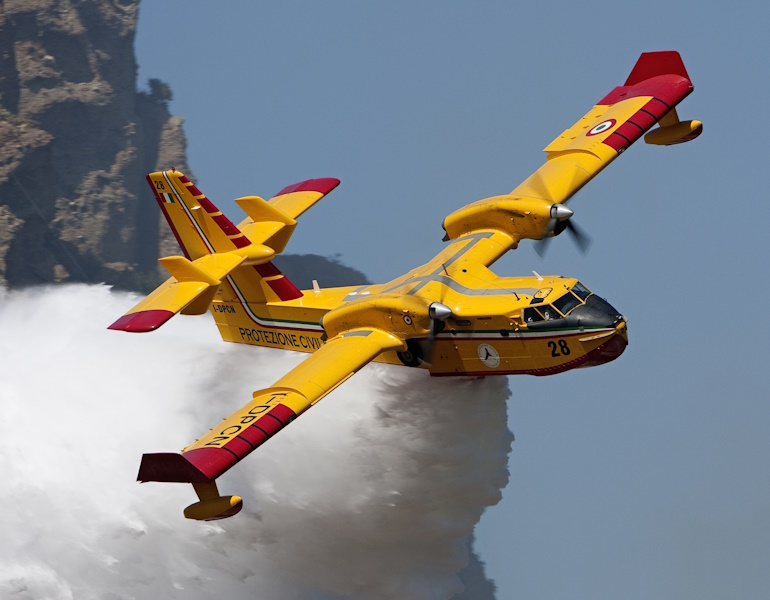
The CL-415 retained the CL-215 airframe, but along with the PWC turboprops, it featured airframe improvements; powered flight controls and a proper glass cockpit; wingtip endplates / winglets to improve stability and allow use of full engine power; "finlets" on the tailplane, plus a bullet fairing at the tailfin-tailplane junction; a larger four-tank water / retardant system; and a stores pylon under each wing. The SAR version was designated "CL-415M".
It is unclear if the CL-215T upgrade brought a CL-215 up to full CL-415 spec. Although the CL-215 / 415 is a much less impressive flying boat than the PS-1 / US-1 or SH-5, the number of CL-215 / 415 machines built shows it to have been much more successful than both of its larger contemporaries put together.
In 2016, Bombardier announced that it had sold off the amphibian product line to Viking Air LTD of British Columbia. Viking Air continued to provide service and support for the CL-215 and CL-415. In 2018, Viking announced an upgrade program to convert CL-215s into the "CL-415 Enhanced Aerial Firefighter" configuration -- featuring general systems updates, along with options for advanced avionics and such. Viking is also offering glass cockpit upgrades to current operators of CL-215T / CL-415 machines.
A new-production variant, the "DHC-515" -- originally "CL-515", the company then deciding to carry on the "De Havilland Canada" designation -- was introduced in 2022, with a glass cockpit and a larger water tank, capable of being loaded in 12 seconds. It could also be quickly converted for aerial spraying or oil spill dispersant, as well as for medevac or cargolift for disaster relief. First deliveries will be in 2025.
BACK_TO_TOP* Incidentally, the ShinMaywa firm used to be rendered in English as "Shin Meiwa", which can lead to confusions. Presumably the change was made to make it easier for foreigners to correctly pronounce, though it's less correct in terms of standard Japanese-English transcription rules.
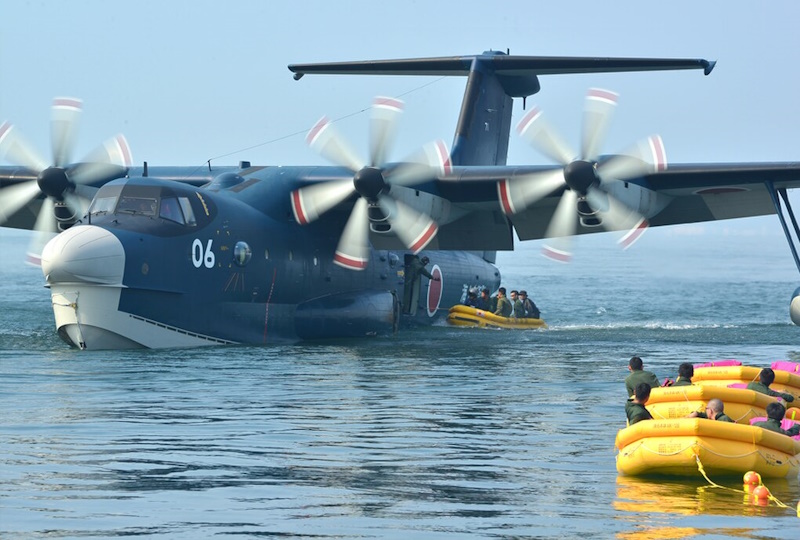
* Sources include:
* Illustration credits:
* Revision history:
v1.0 / 01 may 01 / Originally discussed PS-1 / US-1 only. v1.1.0 / 01 jan 02 / Added comments on Chinese SH-5. v1.1.1 / 01 apr 02 / Minor typo fixes. v1.1.2 / 01 apr 04 / Added US-1A Kai material, small fixes. v1.1.3 / 01 apr 06 / Review & polish. v1.1.4 / 01 feb 08 / Review & polish. v1.1.5 / 01 mar 09 / Jiaolong comments. v1.1.6 / 01 oct 11 / Review & polish. v2.0.0 / 01 jul 13 / Added CL-215 & CL-415, added "US-2" designation. v2.0.1 / 01 jun 15 / Jiaolong updates. v2.0.2 / 01 may 17 / Review & polish. v2.1.0 / 01 apr 19 / Viking Air updates of CL-415. v2.1.1 / 01 feb 21 / Review & polish. v2.1.2 / 01 dec 22 / Review & polish. v2.2.0 / 01 nov 24 / Illustrations update.BACK_TO_TOP
